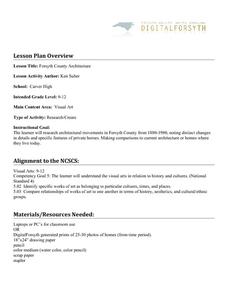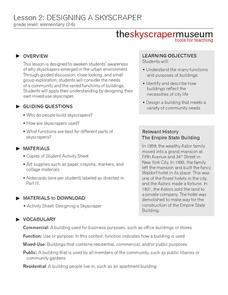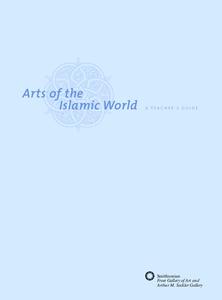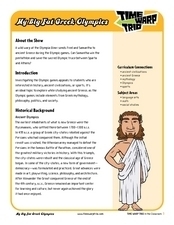Texas Education Agency (TEA)
Byzantine Architecture
View Byzantine architecture from the comfort of your classroom. A PowerPoint presentation introduces important vocabulary terms and examples of Byzantine architecture in the ninth instructional activity of the 11-part series. A Jeopardy...
Partnership for Educating Colorado Students
Mayan Mathematics and Architecture
Take young scholars on a trip through history with this unit on the mathematics and architecture of the Mayan civilization. Starting with a introduction to their base twenty number system and the symbols they used, this eight-lesson unit...
Curated OER
Forsyth County Architecture
What features mark a building as belonging to a particular culture, time, and place? Class members investigate the architectural movements represented in structures built in Forsyth County, North Carolina from 1880-1980 by examining...
Norwich University
Seven Man-Made Engineering Wonders of the Ancient World
Imagine precisely cutting and then moving a 120 ton boulder more than two miles without mechanical cutting tolls, skid loaders, or hydraulic cranes. Imagine carving a stone figure that includes a drainage system that permits rainwater to...
Texas Education Agency (TEA)
Roman Architecture
Design an office fit for the gods. Individuals view a PowerPoint presentation on Roman architecture, its key elements, and famous structures. In groups, they design an office building incorporating the elements of Roman architecture.
Texas Education Agency (TEA)
Romanesque Period
What defines architecture from the Romanesque Period? The last installment of an 11-part unit on architecture focuses on elements and examples of Romanesque architecture. Scholars complete a review worksheet after viewing a PowerPoint...
Describing Egypt
Temple of Isis (Philae)
How did the Temple of Isis change throughout history? The resource discusses how architecture changed purposes over the time periods of the Pharaonic Era and the Greco-Roman Era. It gives a glimpse into what life was like and provides...
American Institute of Architects
Architecture: It's Elementary!—Fifth Grade
Young citizens construct an understanding of urban planning in this cross-curricular unit. Covering every aspect of city development from the political, economic, and social influences to sustainable building practices, this 10-lesson...
Skyscraper Museum
Designing a Skyscraper
Besides serving as awe-inspiring monuments of human achievement, skyscrapers are built to perform a wide range of functions in urban communities. The second lesson in this series begins by exploring the history of the Empire State...
Global Oneness Project
Documenting Architectural Heritage
Imagine going from being one of the richest, most important cities in the world to one of the poorest. Imagine the history captured in the architecture of such a city. Imagine these same now abandoned buildings being destroyed. How would...
Describing Egypt
Ptah-Hotep and Akhet-Hotep Mastaba
Did you know that mastaba means bench in Arabic? Learn why a mastaba was so important to ancient Egyptian architecture. Middle and high schoolers alike stay entertained while reading a passage that describes the virtual tour of...
Describing Egypt
Horemheb - (18th Dynasty)
Who was Horemheb and why is his tomb so famous? An fascinating resource uses virtual reality tools and even comes equipped with the ability to use a VR headset. Learners view information panels to the side of the location to understand...
Describing Egypt
Ty Mastaba
Many know the beauty of a pillared hall, but what makes those from ancient Egypt so breathtaking? An eye-catching resource takes viewers on a journey through the Ty Mastaba to discover the importance of pillars to architecture. They see...
Smithsonian Institution
Arts of the Islamic World
Learn more about the history and five pillars of Islam with an extensive resource that focuses on the religion's connection to art. Focusing on calligraphy, textiles, and architecture, the packet illustrates the beauty of the artistic...
Mr. Roughton
Chinese Dynasties
From the Q'in to the Ming, get the facts on the great Chinese dynasties from early history with these great handouts and worksheets. Presented in a Word document, they include the years the dynasties were in existence, the dynasty...
Skyscraper Museum
Changes in a City Over Time
Investigate the growth and development of New York City with the final instructional activity in this four-part series on skyscrapers. Learners first explore the concept of urban growth by looking closely at a series of three paintings...
Time Warp Trio
My Big Fat Greek Olympics
The Olympic Games are indeed a significant and far-reaching cultural component in our international community today, but from where do they originate? Where do our traditions stem from, and how do we choose the sports that constitute...
American Museum of Natural History
Making a Field Journal
Trowels and brushes are certainly important tools for an archaeologist working on a dig. Perhaps more important, however, is the archaeologist's field journal. Christina Elson, an archaeologist working with the American Museum of Natural...
Curated OER
Native Americans of the Chesapeake Bay: Using Primary vs. Secondary Sources
Discover the rich Native American culture that existed at the time of early European exploration into the Chesapeake region through analysis of several primary and secondary sources.
American Museum of Natural History
Being An Anthropologist: Laurel Kendall
Imagine studying Korean culture, especially the role of women, as well as marriage and religious rituals from home! Anthropologist Laurel Kendall shares what she has learned from her many trips to this fascinating country half a world away.
Curated OER
The Early Ottoman Empire: 1281 - 1600s
Once one of the most powerful civilizations in the known world, the Ottoman Empire was all-encompassing and highly influencial in the Middle East. Enjoy maps that detail the Ottomans' rule, as well as pictures of relics and architecture...
University of California
Bread and Circuses: Rome as a Site of Encounter
An intriguing lesson uses 12 Roman artifacts to explain Roman society and politics. Young historians view images of artifacts and learn how each one represents an aspect of Roman society. Academics also complete a hands-on activity to...
BW Walch
Wondering About the New Seven (Man-Made) Wonders of the World
Who determines the Seven Wonders of the World, and what criteria is used to evaluate these locations? Discover the efforts to promote cultural diversity and preserve man-made monuments during the world's first-ever global vote in 2007 to...
Tutankhamun
Pharaohs, Pyramids and the World of the Gods
Your young historians will learn all about the pharaohs, pyramids, and gods of ancient Egypt with these informational text worksheets, each of which are accompanied by hands-on, follow-up activities.
Other popular searches
- Ancient Architecture
- Ancient Greek Architecture
- Ancient Roman Architecture
- Ancient Architecture Rome
- History of Architecture
- Ancient Architecture Greece
- History Architecture

























